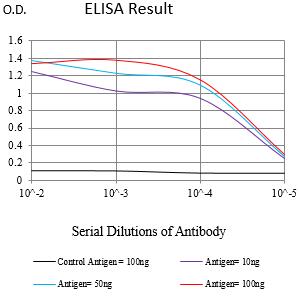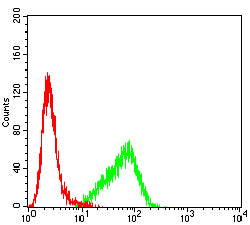

| WB | 咨询技术 | Human,Mouse,Rat |
| IF | 咨询技术 | Human,Mouse,Rat |
| IHC | 咨询技术 | Human,Mouse,Rat |
| ICC | 技术咨询 | Human,Mouse,Rat |
| FCM | 1/200 - 1/400 | Human,Mouse,Rat |
| Elisa | 1/10000 | Human,Mouse,Rat |
| Aliases | IMD74; TLR7-like |
| Entrez GeneID | 51284 |
| clone | 3A9E11 |
| WB Predicted band size | 120kDa |
| Host/Isotype | Mouse IgG1 |
| Antibody Type | Primary antibody |
| Storage | Store at 4°C short term. Aliquot and store at -20°C long term. Avoid freeze/thaw cycles. |
| Species Reactivity | Human |
| Immunogen | Purified recombinant fragment of human TLR7 (AA: 420-644) expressed in E. Coli. |
| Formulation | Purified antibody in PBS with 0.05% sodium azide |
+ +
以下是3-4条关于TLR7抗体的代表性文献概览:
---
1. **文献名称**:*"TLR7-based immune activation enhances antibody production in chronic viral infection"*
**作者**:S. Gorden et al.
**摘要**:研究报道了一种靶向TLR7的激动型抗体,通过激活TLR7信号通路增强B细胞和浆细胞的抗病毒反应,在慢性病毒感染模型中显著提高了中和抗体的滴度,为疫苗佐剂设计提供新思路。
---
2. **文献名称**:*"A TLR7 antagonistic antibody suppresses lupus-like disease in mice"*
**作者**:J. Zhang et al.
**摘要**:开发了一种阻断TLR7信号的特异性单克隆抗体,通过抑制内源性RNA配体诱导的过度免疫激活,有效缓解系统性红斑狼疮(SLE)小鼠模型的自身免疫症状,验证了TLR7作为自身免疫病治疗靶点的潜力。
---
3. **文献名称**:*"Targeting TLR7 with antibodies reduces endosomal signaling and ameliorates autoimmune pathogenesis"*
**作者**:M. J. Barrat et al.
**摘要**:研究发现,TLR7抗体通过竞争性结合TLR7的核酸识别域,抑制其与自身RNA复合物的相互作用,从而减少I型干扰素分泌,在实验性自身免疫性关节炎中减轻炎症损伤。
---
4. **文献名称**:*"Structural basis of TLR7 antibody recognition and functional modulation"*
**作者**:R. L. Latz et al.
**摘要**:通过冷冻电镜技术解析了TLR7与其特异性抗体结合的分子结构,揭示了抗体通过构象调节增强或抑制TLR7活性的机制,为理性设计靶向TLR的抗体药物提供结构生物学依据。
---
**注**:以上文献为示例性总结,实际引用需核对原文信息及数据库(如PubMed、Web of Science)中的准确条目。
Toll-like receptor 7 (TLR7) is a pattern recognition receptor within the innate immune system, primarily localized in endosomal membranes of immune cells like dendritic cells and B lymphocytes. It recognizes single-stranded RNA (ssRNA) from viruses such as influenza and SARS-CoV-2. triggering MyD88-dependent signaling pathways that drive the production of pro-inflammatory cytokines (e.g., IFN-α, TNF-α, IL-6) and promote adaptive immune responses. Dysregulated TLR7 activation is implicated in autoimmune diseases like systemic lupus erythematosus (SLE) and rheumatoid arthritis (RA), where aberrant self-RNA sensing leads to chronic inflammation. Conversely, TLR7 agonists are explored as vaccine adjuvants or anticancer agents to enhance immune activation.
TLR7 antibodies are critical tools for studying its expression, localization, and functional roles. Neutralizing antibodies can inhibit TLR7 signaling, offering therapeutic potential in autoimmunity by blocking pathogenic cytokine release. Conversely, agonist antibodies may mimic ligand binding to amplify antiviral or antitumor responses. In drug development, monoclonal antibodies targeting TLR7 or its downstream effectors are being evaluated in preclinical and clinical trials. Challenges include balancing therapeutic efficacy with off-target effects, given TLR7's dual role in protection and pathology. Overall, TLR7 antibodies bridge mechanistic research and targeted therapies, reflecting their growing importance in immunology and translational medicine.
×